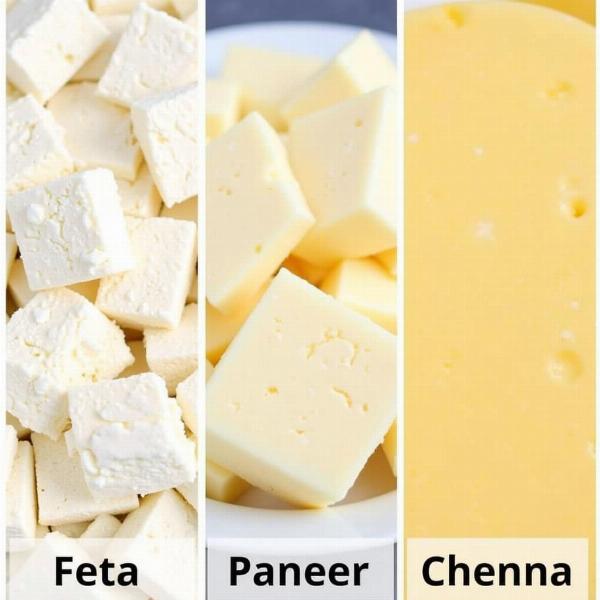Feta cheese, a staple in Greek cuisine, is becoming increasingly popular worldwide. But what exactly is feta meaning in Hindi? This comprehensive guide will explore feta’s meaning, its characteristics, culinary uses, and nutritional benefits. We’ll also delve into how it compares to Indian cheeses, offering a deeper understanding of this tangy, crumbly cheese.
Understanding Feta: More Than Just “Paneer”
While many simply translate “feta” to “paneer” (पनीर) in Hindi, this isn’t entirely accurate. Feta is a brined curd cheese made traditionally from sheep’s milk or a mixture of sheep and goat’s milk. Paneer, on the other hand, is a fresh acid-set cheese typically made from cow or buffalo milk. The differences in production methods and milk sources lead to distinct textures and flavors. Feta boasts a tangy, salty flavor and a crumbly texture, while paneer is milder and firmer.
Feta’s Culinary Journey: From Greece to India
Feta’s versatility makes it a welcome addition to various cuisines, including Indian. Its salty, tangy profile complements the vibrant flavors found in Indian dishes. From salads to curries, feta adds a unique dimension, elevating the taste and texture. Imagine the creamy, tangy feta crumbled over a spicy saag paneer or incorporated into a flavorful stuffed paratha.
What is Feta Called in Hindi? Exploring Regional Variations
While a direct translation doesn’t exist, feta is often referred to as “फीटा चीज़” (feeta cheese) in Hindi. However, depending on the region, you might encounter variations. Some may call it a type of “नमकीन पनीर” (namkeen paneer – salty paneer) due to its briny nature.
Nutritional Benefits of Feta: A Healthy Addition to Your Diet?
Feta provides a good source of protein and calcium, essential nutrients for maintaining healthy bones and muscles. It also contains beneficial bacteria that can promote gut health. However, feta is relatively high in sodium, so moderation is key, especially for individuals watching their salt intake.
Feta vs. Indian Cheeses: A Comparison
While feta offers a unique flavor profile, Indian cheeses like paneer and chenna provide excellent alternatives, especially for vegetarian diets. Paneer’s mild flavor and firm texture make it ideal for grilling or frying, while chenna’s soft and crumbly texture is perfect for desserts like rasgulla.
 Comparison of Feta, Paneer, and Chenna
Comparison of Feta, Paneer, and Chenna
Conclusion: Embracing Feta in Indian Cuisine
Feta, with its distinct salty and tangy flavor, is more than just a Greek cheese; it’s a versatile ingredient that can enhance Indian dishes. While not a direct equivalent to paneer, it offers a unique culinary experience. So, next time you’re looking to add a flavorful twist to your meals, consider incorporating feta.
FAQ: Common Questions about Feta
- Is feta vegetarian? Yes, feta is traditionally vegetarian, made from sheep or goat’s milk. However, some variations may use rennet from animal sources, so always check the label.
- Where can I buy feta in India? Feta is readily available in most major supermarkets and specialty cheese shops across India.
- How should I store feta? Store feta in its brine in an airtight container in the refrigerator.
- Can I freeze feta? While freezing is possible, it can alter the texture, making it crumblier.
- What are some popular dishes using feta? Feta is delicious in salads, omelets, pizzas, and even crumbled over curries.
- Is feta healthy? Feta provides protein and calcium but is also high in sodium. Consume it in moderation as part of a balanced diet.
- What is the best way to use feta in Indian cooking? Crumble it over salads, mix it into curries, or use it as a stuffing for parathas.